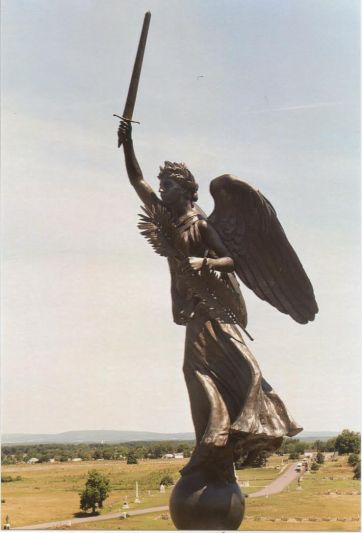One day, while giving a tour of the field of Pickett’s Charge, I kept referring to the Union artillery line of Lt. Col. Freeman McGilvery. For much of July 2 & 3, 1863 McGilvery’s guns occupied the long stretch of Cemetery Ridge from near the intersection of modern day Pleasanton Avenue south to the George Weikert Farm. Standing near the Point of Woods on Seminary Ridge, it is difficult to identify the location, but as a reference point, I kept pointing to the “winged angel” atop the Pennsylvania Monument. After a few minutes, a tour participant asked “who’s the lady atop the building?”

The Pennsylvania Memorial dominates the southern half of the Gettysburg battlefield. The largest, costliest, and most ornate monument on the battlefield, it stands in tribute to the Pennsylvanians who fought, and died, on the fields which it towers over. Perched atop the dome is a distinctive and evocative bronze figure of an angel. Clutching a sword in one hand and a palm branch in the other, she is frozen in the act of moving forward toward an unseen foe. But who is she?
On June 13, 1907, Gov. Edwin Stuart appointed nine Union veterans to The Gettysburg Battlefield Memorial Commission. The Commission had the task of finding a suitable location for the Pennsylvania State Memorial “to commemorate the services of the soldiers of Pennsylvania in the battle.” The Commonwealth appropriated $140,000 for the construction, $10,000 for the dedication ceremonies, $20,000 to reimburse the railroads for transportation, and another $40,000 to furnish bronze statues of Abraham Lincoln, Gov. Andrew Curtin, and six general officers of Pennsylvania. In 1908, fifty-one designs for the new monument were submitted. The model of architect W. Liance Cottrell ultimately won.

Initial design of the Pennsylvania Memorial. (GNMP)
Cottrell’s design incorporated the beaux-arts style “which advocated a grandeur in architecture, a merging of several styles (as here, baroque and neoclassical), and a rich adornment by various media, especially sculpture.” The style had become popular in America during the 1890’s. In order to tell the story of Pennsylvania at Gettysburg, the monument incorporates the names of all the state’s army, corps and division commanders along the exterior cornice and the interior cornice features the name of twenty-four brigade officers. Every soldier that served from Pennsylvania is listed on eighty-four bronze tablets that line the base exterior of the monument. In 1911, eight bronze, larger than life, statues of such figures as Lincoln, Curtin, and Meade were installed. The Pennsylvania Monument assimilates 1,252 tons of granite, 1,410 tons of broken stone, 740 tons of sand, 366 tons of cement, 50 tons of steel bars, and 22 tons of bronze for a total of 3,840 tons of material.
Samuel Murray was selected to make the statue to crown the monument. He was one of

Samuel Murray. (LOC)
the leading sculptors in America at the time. Based in Philadelphia, he had studied under
the famous painter Thomas Eakins. Murray’s previous sculptures, which won gold and silver medallions, had been displayed nationally and in Paris. Over the course of his career, his works included the statues of Commodore John Barry in Independence Square, Senator Boies Penrose in Harrisburg, Bishop Shanahan Memorial in St. Patrick’s Cathedral in Harrisburg, the prophets on the Witherspoon Building in Philadelphia, and the Father William Corby Statue at Gettysburg.
Murray was commissioned to cast the bronze statue of Victory to crown the dome of the Pennsylvania Monument. As his inspiration, he chose the Winged Victory of Samothrace from classical antiquity. Exhibited at the Louvre in Paris, this statue dates from the second century B.C. and is known for its incorporation of “theatrical stance, vigorous movement, and billowing drapery.”

Winged Victory of Samothrace. Image courtesy of the Louvre.
Augustus Saint-Gauden’s Sherman Memorial in New York may have also influenced Murray. Erected in 1903, Saint-Gauden’s winged goddess had garnered much public praise and certainly Murray was aware of this fact.

The Sherman Memorial by Augustus Saint-Gauden. Image courtesy of City University of New York.
For his version, Murray altered Victory to include the olive branch in her left hand and the sword in her right. The addition of this symbolism made the statue represent both peace and war. As a final touch, Murray cast Victory from melted cannon, linking her in a tangible way to the American Civil War.

Today, the “Goddess of Victory and Peace” still stands, ever watchful, symbolically leading the Pennsylvania troops forward! She remains one of the most iconic images on the battlefield.
Ranger Matt Atkinson
Gettysburg National Military Park
Post Script: The pictures of Victory come from the collection of Barb Adams. Barb has volunteered with the cannon restoration shop and visitor services for many years. In 2013, Victory received preservation treatment and Barb went up in the lift for a close up view. Many thanks to her for these pictures!

Also known as Nike of Samothrace.
Sent from my iPhone
>
My favorite monument on the Gettysburg Battlefield. Next would be the Irish Brigade monument.
And you could have said that Samuel Murray used his mother’s face for Nike’s (in honor of Mother’s Day!)
Pingback: Gettysburg’s Pennsylvania Memorial – The Bookish Wanderer